|
|
Кацусика Хокусай. Тридцать шесть видов Фудзи: № 45. Болото Кадзикадзава в провинции Каи
Katsushika Hokusai. Kajikazawa in Kai Province, from the series Thirty-six Views of Mount Fuji
冨嶽三十六景 甲州石班沢Kajikazawa in Kai Province (Kōshū Kajikazawa), from the series Thirty-six Views of Mount Fuji (Fugaku sanjūrokkei)Artist: Katsushika Hokusai (1760–1849)Period: Edo period (1615–1868)Date: ca. 1831–32
The repetition and rhyme of shapes and colors in the foreground and background make this one of the most unified, handsome designs in the series. The triangular shape formed by the fishing lines, the fisherman's arched back, and the promontory from which he fishes echoes that of Fuji on the horizon. The visual relationship between man in the foreground and nature in the background is enhanced by the deep Berlin blue coloration Hokusai gave to the fisherman's jacket, the apex of the shoreline in the foreground, and the summit of Fuji. The first impression of this print features the indigo technique; the number of colors was increased in later impressions. (The Metropolitan Museum of Art)
This print is one of Hokusai’s most successful and evocative designs in the Fuji series. In its simple composition, with only a few elements, Hokusai presents the close interaction between natural forces and fragile, yet durable men. The pounding waves and wind-driven rain seem mercilessly cruel to humans, but at the same time, these forces also provide man with a way of life when he is determined to survive. Fuji rises in the near distance, revealing its summit through thick fog. Standing in the river on a rugged rock washed by the turbulent waves, a fisherman casts his net lines. His determination to make a good catch is expressed in his posture – foot firmly gripping the rock and body bent to hold the lines. His little son, sitting on the rock below him, tends the fish basket. They exchange no word, but they are perfectly united in their dangerous endeavor. As with most of Hokusai’s great designs, this composition is organized by a simple geometric principle: repetition of similar forms in varied locations. The left slope of Fuji is mirrored in the line created by the form of the large rock, the child’s head, and the bending body of the fisherman. The right slope of the mountain is repeated by the net lines. The waves repeat the triangular shape of the mountain. This print shows a typical basic color scheme of blue. The key-block was printed in blue. (The Asian Art Museum of San Francisco, HOKUSAI AND HIROSHIGE – Great Japanese Prints from the James A. Michener Collection, Honolulu Academy of Arts: The Asian Art Museum of San Francisco, 1998 Page 69. Cat. 20)
Together with the related print Great Wave, this is one of the most effective compositions ever designed by Hokusai. It is dominated by a diagonally jutting rock that rises from the left over the rough waters of the Fuji River. The line of the rock is continued by a fisherman standing determinedly on its edge, and by the left slope of Mount Fuji, culminating in the summit at the top of the print. The fisherman’s lines rise at an opposing angle, matching the right slope of the volcano and the posture of the young boy who crouches over a basket below the man. The tension of these two opposing diagonals is gradually eased through the sweeping lines of mist beyond the river, until it is finally resolved in the serene horizontal bands of clouds in the sky. This is an early aizuri-e (“blue printed picture”) impression printed entirely in imported Prussian blue. Later impressions add green for the rock and brown for the figures, reducing the seamless continuity between human and natural elements that makes the design so remarkable. “Hokusai’s Summit: Thirty-six Views of Mount Fuji” (09/24/2009-01/06/2010)
Болото Кадзикадзава в провинции Каи
Название, которое фигурирует в гравюре, вероятно, отражает ошибочное представление о том, что такое Кадзикадзава. На самом деле, Кадзикадзава — это местность в пойме знаменитой реки Фудзигава, которая образована при слиянии двух рек — Фуэфукигава и Камамугава. Известно, что в Китае название Кадзикадзава писалось другими иероглифами, но читалось как «кадзика», что в переводе означает «бычок», то есть — название рыбы. Вероятно, отсюда и пошло подобное написание названия данной местности. Фудзигава — это одна из трех самых крупных в Японии рек с самым быстрым течением. В этой гравюре, как и во всех листах серии, Фудзи принадлежит совершенно особая роль. Она одновременно и конкретная деталь ландшафта, и символический образ, олицетворяющий идею родины. Фудзи, словно рожденная самой водной стихией, появляется над туманными бело-голубыми далями, доминируя над пространством. Художник очень живо передает течение реки. Разбрасывая пенистые брызги, волны ударяются о причудливо вздыбившуюся скалу, нависающую над бушующей водой. При помощи горизонтальных линий на втором плане, которые снова и снова пересекаются и накладываются друг на друга, он изображает мощную силу воды. Эти линии плавно переходят в туман, и, кажется, вот-вот поглотят скалу и находящихся на ней рыбака и мальчика. Хокусай сопоставляет далекое бесконечное пространство и маленькую фигуру рыбака, словно затерянного в безбрежных просторах. Казалось бы, обыденный момент, но он приобретает значение важного события. Вместе с тем, в этом листе отсутствует точная достоверность. Линия скалы, фигура рыбака, сети справа — все слагается в ясный треугольник, повторяющий очертания конуса горы Фудзи. Благодаря этим соотношениям подчеркивается единство композиции. Рыбак становится как бы соразмерным Фудзи, а обыденное приобретает значение возвышенного, жанровая тема несет теперь символический подтекст, появляется эпичность. Хокусай добивается не зрительной достоверности, а постоянно ищет средство для наиболее убедительного воплощения главного замысла гравюр. Все эти элементы формируют отличительную особенность и неповторимость характера творчества мастера.
Все 46 гравюр серии «Тридцать шесть видов Фудзи» | Thirty-six Views of Mount Fuji | 富嶽三十六景 | Fugaku Sanjūrokkei
24 февраля 2024, 11:21
0 комментариев
|
Партнёры
|















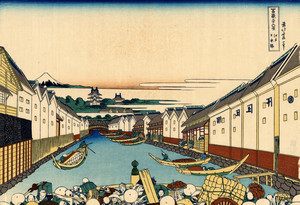




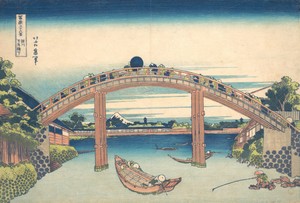











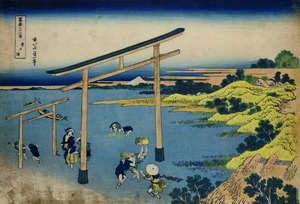
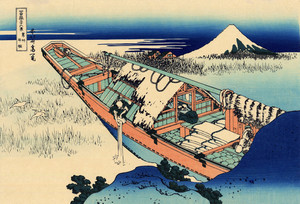









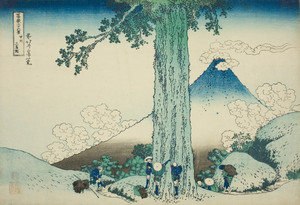









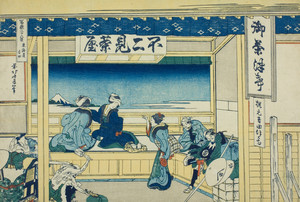



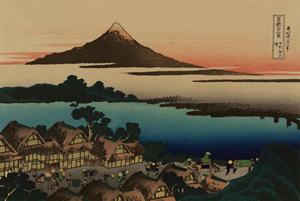








Комментарии
Добавить комментарий